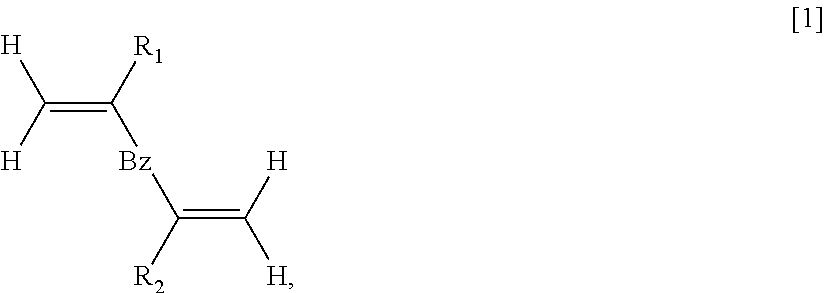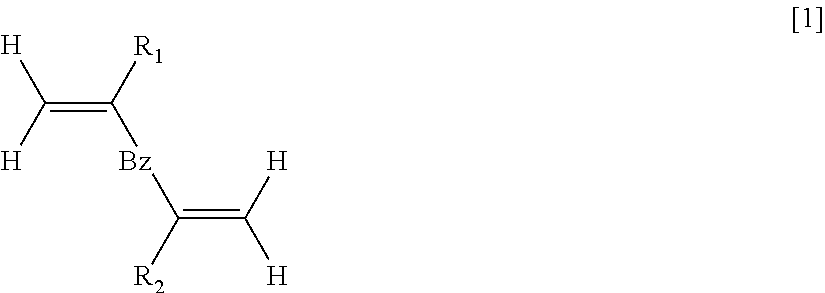Polymer for filler for preprocessing column
a polymer and preprocessing column technology, applied in the field of new polymer, can solve the problem of not being able to efficiently absorb all the above-described target components, and achieve the effect of efficient separation, simultaneous and efficient measurement, and sensitive measuremen
- Summary
- Abstract
- Description
- Claims
- Application Information
AI Technical Summary
Benefits of technology
Problems solved by technology
Method used
Image
Examples
example 1
Synthesis of Polymer-1 of the Present Invention
[0097]As a hydrophobic monomer, 85.0 g of divinylbenzene (produced by Nippon Steel Chemical Co., Ltd.) (purity: 80%) (containing 0.52 mol of pure divinylbenzene), as a polar monomer (monomer in which ion exchanging group can be introduced), 15.0 g (0.106 mol) of glycidyl methacrylate (produced by Wako Pure Chemical Industries, Ltd) were used, and as a water-insoluble organic solvent, 100 g of toluene was used. 1.0 g of azobisisobutyronitrile (produced by Wako Pure Chemical Industries, Ltd.) was added to mixed solvent of 2 kinds of the above-described monomers and the water-insoluble organic solvent, and dissolved. Then, mixed solution was suspended in 0.8 Lgggg of 0.2% by weight aqueous solution of methylcellulose, and was stirred at high speed to adjust the average diameter of oil droplet to about 60 μm. Then, mixed solution was transferred to polymerization apparatus equipped with stirrer, and was reacted at 80° C. for 6 hours to obta...
example 2
Synthesis of Polymer-2 of the Present Invention
[0100]Cross-linked porous copolymerized particles were obtained using the similar procedure to Example 1. The obtained cross-linked porous copolymerized particles had 10.56 nm of average micropore diameter and 662.5 m2 / g of specific surface area. These particles were classified using 32 μm and 63 μm sieves. Diethylamino group was introduced to the porous copolymer by the similar procedure to Example 1 except that 15.5 g of diethylamine (produced by Wako Pure Chemical Industries, Ltd) was used instead of 18.5 g of morph line, and thus, the resultant polymer was defined as polymer-2 of the present invention. It should be noted that, content of diethylamino group in the obtained polymer-2 of the present invention was 0.56 mmol / g. In addition, structure of polymer-2 of the present invention is shown as follows.
[0101]
example 3
Addition and Recovery Experiment of the Perfluoro Compound Having the Acidic Group (PFCs) Using Polymer-1 of the Present Invention, Polymer-2 of the Present Invention
1. Preparation of Column and Sample
1-1. Preparation of Column
[0102]Each of 60 mg of Polymer-1 and 60 mg of polymer-2 of the present invention prepared in Example 1 and Example 2 was filled into the 3 ml of polypropylene syringes (manufactured by Pronics Co. Ltd) equipped with filter having 20 μm of micropore diameter (Yoko Co., Ltd) at upper and lower ends respectively. These were defined as solid-phase extraction column-1 and solid-phase extraction column-2.
1-2. Preparation of the Sample
[0103]In 1000 ml of the purified water, 13 kinds of the perfluoro compounds having the acidic group [perfluoro sulfonic acids: PFBS (produced by Wako Pure Chemical Industries, Ltd); PFHx (produced by Wellington Co., Ltd); PFOS (produced by Accustandard, Inc.); PFDS (produced by Wellington Co., Ltd); perfluoro carboxylic acid: PFPeA, PFH...
PUM
 Login to View More
Login to View More Abstract
Description
Claims
Application Information
 Login to View More
Login to View More - R&D
- Intellectual Property
- Life Sciences
- Materials
- Tech Scout
- Unparalleled Data Quality
- Higher Quality Content
- 60% Fewer Hallucinations
Browse by: Latest US Patents, China's latest patents, Technical Efficacy Thesaurus, Application Domain, Technology Topic, Popular Technical Reports.
© 2025 PatSnap. All rights reserved.Legal|Privacy policy|Modern Slavery Act Transparency Statement|Sitemap|About US| Contact US: help@patsnap.com



